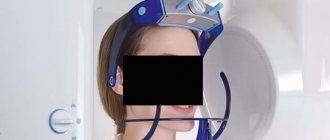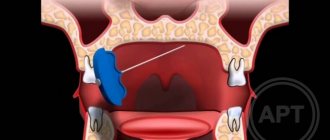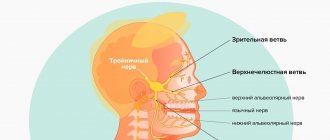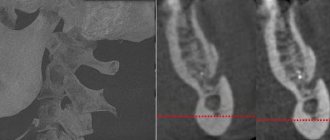What is the trigeminal nerve
The human face has many muscles and nerve endings. Not only the mucous membranes of the nose, pharynx, and conjunctiva, but also the nerve endings can become inflamed. This is most often associated with neurological disorders that change the sensitivity of the fibers that conduct impulses.
With neuropathy of the facial area, acute shooting pain occurs on the right or left. Mirror inflammation of the trigeminal nerve is extremely rare. It is located in the temporal region, near the base of the auricle. And from it there are branches along the entire half of the face:
- jaw nerve (upper and lower);
- optic nerve;
- infraorbital nerve.
The trigeminal nerve passes through the bone tissue in several places, which plays an important role in the occurrence of inflammation associated with pinching. Thus, inflammation of the trigeminal nerve can result in acute pain both in the upper and lower jaw, and in the forehead area, covering the eye sockets.
Location of the sciatic nerve
This nerve begins in the pelvis, in the lumbar spine. It is very long, due to which it covers a large proportion of the lower parts of the body. From the sacrum its branch exits through the infrapiriform foramen into the pelvis. Then it goes under the gluteal muscle, and is further divided into smaller parts that penetrate the muscles of the buttocks and thighs. The sciatic nerve simultaneously affects each joint of those located in this area.
The sciatic nerve provides sensation to the lower extremities
Descending to the popliteal fossa, it diverges into two branches: the tibial and fibular branches. Without these very branches of the nerve, not a single area of the skin of the legs would have sensitivity. Also, without it, the sensitivity of the muscles and joints of the legs is unthinkable.
Causes of inflammation of the trigeminal nerve
There are several reasons leading to inflammation of the nerve ducts:
- Poor blood supply associated with physical compression of the nerve. First of all, this is swelling caused by diseases of the ENT organs. The resulting tumor can also pinch the nerves.
- Inflammation associated with dentistry. This includes gingivitis, periodontitis, caries, pulpitis, and eruption of wisdom teeth. Each of these diseases can lead to suppuration, abscesses, swelling and bacterial infections of tissues.
- Medical error by an anesthesiologist - if the injection was given unsuccessfully and the needle got into a nerve, pain cannot be avoided.
- Hypothermia causes muscles to lose their elasticity, which leads to pinching of the nerves passing between the fibers.
- Bacterial infections, in particular tetanus and polio.
- The cause of inflammation of the trigeminal nerve, which is difficult to diagnose, is the psychological state of a person - frequent experiences, stress, and nervous disorders.
To determine the cause of inflammation, you need to consult a specialist.
Sciatica pain
The pain caused by sciatica is quite varied. There are burning and shooting ones. There are piercing and pulling. And there are also whining ones. But usually they come in fits and starts. In other words, unbearable pain and periods of relative peace follow each other.
Treatment methods
Depending on what caused the inflammation, a course of treatment is prescribed. For bacterial lesions, the emphasis is on antibacterial therapy through systemic administration of drugs.
However, regardless of the reasons, the doctor prescribes painkillers to relieve pain and reduce inflammation. It could be:
- ibuprofen;
- paracetamol;
- analgin;
- ketorol;
- diclofenac.
All of the listed drugs can be prescribed either in the form of tablets for oral administration, or prescribed in the form of solutions for intramuscular administration.
When conservative methods are not possible, the help of a surgeon may be needed. This primarily concerns abscesses due to the eruption of wisdom teeth, pulpitis or other dental diseases. In this case, the abscess will be opened, pus will be removed, the wound will be treated with antiseptic, and the tooth will be removed, if necessary. If a pinched nerve occurs as a result of pathologies in the structure of the skull, the surgeon will perform an operation to correct the situation and free the nerve bundles.
As a complex therapy, massage, heating or exposure to a magnetic field and electric current can be prescribed. You cannot massage or warm the inflamed area yourself, because this can lead to complications associated with rupture of the purulent capsule, blood poisoning and paralysis of the facial nerve.
Separately, you may need to consult a neurologist who will determine the cause of the inflammation if other specialists have not found obvious foci of infection and abscesses.
Traditional methods of treatment are permissible only as an addition to the main therapy. For example, rinsing with chamomile decoction will relieve inflammation and reduce swelling. But you can resort to such procedures only with the permission of the attending physician.
Why does sciatica begin to develop?
Inflammation of this nerve may well be caused by the following factors:
- uncomfortable ambient temperature;
- stressful situations;
- pathologies of the spine, due to which the nerve can become inflamed or pinched;
- spinal injuries;
- diabetes;
- infections;
- lifting too heavy loads;
- lack of physical activity;
- pregnancy;
- drinking alcohol;
- poisoning with any heavy metal;
- gout.
There are many reasons for inflammation of the sciatic nerve
Moreover, sciatica does not necessarily begin because of just one single factor.
There are professions in which the likelihood of getting this pathology is slightly higher than in other jobs. Eg:
- farmer;
- machine operator;
- driver.
It is also exceeded among those whose workplace is not comfortable enough, as well as among smokers.
Also, sciatica can either appear suddenly, for example, due to an injury, or develop gradually, which results from difficult work and/or complications from other pathologies.
Possible complications
Doctors call facial paralysis the first complication that appears in the absence of adequate treatment. This means that a person who does not receive medical care in a timely manner is deprived of the opportunity to express his emotions through facial expressions on one side of his face. This condition can no longer be corrected, which will certainly affect the quality of life. Distortion of facial expressions will lead to the development of depression and constant dissatisfaction with one’s appearance. Not every patient can come to terms with irreversible changes in their appearance without deep distress.
One of the most unpleasant manifestations of paralysis is the inability to close the eyelids on the injured side of the face. In this case, the eye will have to be regularly instilled with artificial tears to prevent the cornea from drying out, since natural hydration through blinking becomes unavailable for this eye.
Symptoms
The following symptoms of inflammation of the facial nerve are distinguished:
- partial or complete impairment of facial muscle movements;
- the corner of the mouth lowers, the nasolabial fold on one side is smoothed out;
- the face becomes asymmetrical;
- the eyelid does not close completely;
- the eyeball protrudes and turns upward;
- pain in the ear, taste disorder;
- watery or dry eyes;
- hearing loss or sensitivity to loud sounds;
- the patient cannot whistle or stretch out his lips with a straw.
Prevention of inflammation
To prevent the risk of developing inflammation of the trigeminal nerve, it is recommended to follow a number of measures:
- monitor oral hygiene and consult a dentist in a timely manner;
- do not stay in the cold for a long time or protect your face from freezing with a scarf;
- do not self-medicate otitis media.
At the first manifestations of pain on the face, you should immediately consult a doctor. This will stop the development of inflammation. In addition, early diagnosis allows for conservative treatment methods.
Sciatica therapy
When treating sciatica, medicinal and non-medicinal methods can be used. How it is carried out is determined by the degree of pathology, as well as the original cause - that is, the nerve is inflamed or pinched. If necessary, doctors may resort to surgery. But the operation is performed only as a last resort, when other methods of combating the disease have been found to be unsuccessful.
Here is a list of non-drug treatments for sciatica:
- physiotherapy;
- hydrotherapy;
- massage;
- exercise therapy;
- visiting the gym.
There are many methods for treating sciatica
There are also non-traditional, but still effective therapeutic methods:
- acupressure;
- ozone therapy;
- manual therapy;
- mud therapy;
- cupping massage;
- acupuncture therapy;
- leech treatment.
Drug treatment methods for sciatica
When treating sciatica, the main focus is on medication. Let's talk about the main groups of medications that are used to cure sciatica.
Despite the fact that the purposes of using glucocorticosteroids coincide with NSAIDs, the methods of their use are quite different. Any steroids should only be used to relieve symptoms if carefully supervised by a specialist. As well as using any narcotic drugs designed to relieve pain, for example, morphine and tramadol.
Sometimes the patient is prescribed medications belonging to different categories.
Typically, topical medications are used, produced in the form of ointments and creams. There are also vitamins and medications for pain and inflammation that can be used in the form of inhalations or injections during exacerbations and/or severe pain.
The patient may be prescribed NSAIDs
If you need medication in tablet form, it is recommended that you first consult a specialist. There are quite a few NSAIDs whose side effects override their beneficial effects or at least make them less attractive from this point of view. For example, some tablets disrupt the gastrointestinal tract and also cause bleeding and ulcers. Moreover, the risk is greatest when using such products for a long time. So NSAIDs are used only during exacerbations, which require effective pain relief techniques. Tablets should not be taken for more than 5-14 days, which is determined by the drug itself.
Causes of postherpetic neuralgia
Once a person has had chickenpox, the virus remains in the body for life. With age, the immune system weakens (particularly from taking medications or chemotherapy) and the virus can become more active, resulting in shingles.
Damage to nerve endings during rashes leads to postherpetic neuralgia. When damaged, nerve fibers cannot send signals from the skin to the brain as they normally do. Instead, they transmit amplified signals, and the patient feels excruciating pain that can last for months or even years.
What does treatment of myositis include in our clinic?
Our specialists use the most effective methods in the treatment of myositis. Prescriptions such as:
- A course of anti-inflammatory drugs. Episodic use of medications is not enough; a systematic approach is required in their use.
- Anti-inflammatory and warming topical agents (ointments, gels, compresses).
- Massage using pain-relieving gels.
- Physiotherapeutic procedures - magnetic therapy, etc.
If abnormalities in the structure of the intervertebral discs are diagnosed, then treatment is prescribed to prevent the progression of osteochondrosis and recommendations are given on how to comply with preventive measures.
Classification
Neuritis of the facial nerve can be primary or secondary.
The primary form of inflammation occurs as an independent disease in a healthy person due to hypothermia. This type of neuritis is called catarrhal neuritis.
The secondary form of inflammation develops against the background of infection, otitis media or another disease.
In the vast majority of cases, the disease is acquired, much less often it is congenital.
The congenital nature of the disease may be indicated by Melkersson-Rosenthal syndrome - swelling of the face combined with folding of the tongue.
How to avoid diseases associated with back hypothermia
Recommendations for the prevention of diseases of the spinal column include everything related to a healthy lifestyle. To successfully resist inflammatory diseases and degenerative processes in the joints, you need to lead an active lifestyle, but not overload. General physical training, gymnastics, and swimming are excellent for strengthening joints. When doing running and other sports that create impact loads on the spine, you need to take precautions: buy high-tech shoes designed for these purposes, do not run on hard surfaces, and always warm up your joints. It is also necessary to strengthen the immune system with proper nutrition and hardening, and avoid traumatic situations.
Which specialist can help with sciatica?
In the treatment of sciatica, the help of a neurologist is needed. It may also be necessary to consult other doctors:
- vertebrologist;
- neurosurgeon;
- vascular surgeon.
The “main” doctor to contact for sciatica is a neurologist, but he can also refer you to other specialists
During the treatment process, you also need the help of a physiotherapist, exercise therapy and massage specialist. The services of an osteopath may be helpful.
Types of disease
- Epidemic parotitis - in this case, intoxication of the body occurs due to viruses.
- Otitis media – Otitis media leads to perforation of the eardrum, causing infection in the facial nerve.
- Hunt's syndrome - a herpetic rash occurs on the anterior part of the tongue and ear. Due to the penetration of microbes, the salivary glands become inflamed, resulting in compression of the facial nerve.
- Merkenson-Rosenthal syndrome is a rare type of neuritis that is hereditary.
Neuritis of the facial nerve in a child
The causes of damage to the facial nerve in a child can be as many as in an adult: hypothermia;
- inflammation of the middle ear;
- damage to the facial nerve itself.
A reliable symptom of the development of the disease is the skewing of the mouth in the healthy direction when trying to bare teeth. Treatment of the disease in younger patients depends on its etiology, but usually recovery occurs within 2-3 weeks. In some cases (when the cause is a serious illness), more time is required.
During therapy for fever, antipyretics are prescribed. In the acute phase of neuritis, anti-inflammatory and vasoactive medications are also prescribed. During the remission phase, exercises may be prescribed, which the child performs first with a doctor and then with a parent.
What are the benefits of going to the clinic?
The main advantage of visiting a medical facility for back pain is the opportunity to undergo an accurate diagnosis. After all, pain after hypothermia can occur not only with myositis, but also with much more serious diseases of the spine: protrusions, ordinary and sequestered hernia.
Having undergone diagnostics using modern highly informative devices, you will know exactly the cause of pain after hypothermia. If the pain is caused not by simple muscle inflammation, but by degenerative changes in the structure of the intervertebral discs, then you will be prescribed treatment that will help prevent further progression of the disease, which, without timely treatment, can lead to disability.
But it can blow out the lower back even with a healthy spine. In this case, treatment prescribed by a doctor will help you quickly cope with the disease and return to your normal rhythm of life. In this case, the likelihood of the disease becoming chronic will be minimized.










